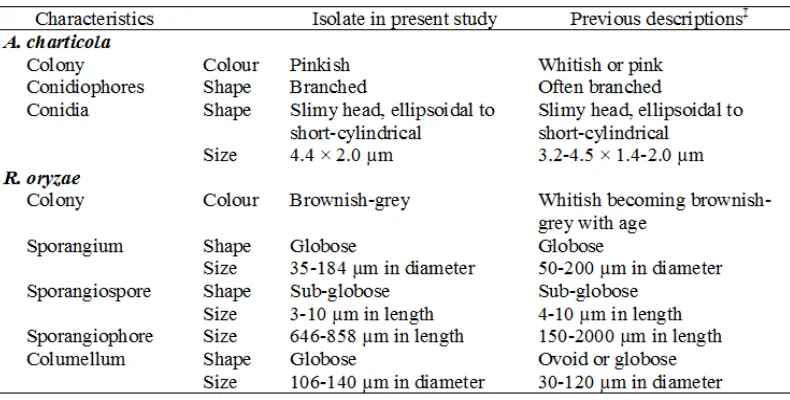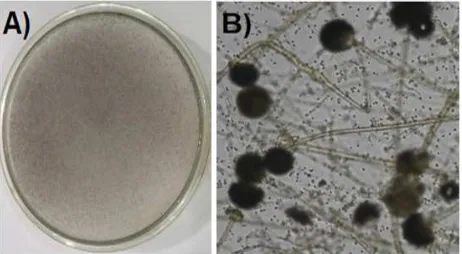© All Rights Reserved
*Corresponding author. Email: [email protected]
International Food Research Journal 23(3): 1351-1354 (2016)
Journal homepage: http://www.ifrj.upm.edu.myYudiarti, T. and
*Sugiharto, S.
Faculty of Animal and Agricultural Sciences, Diponegoro University, Semarang, Central Java Indonesia
A novel ilamentous fungus
Acremonium charticola
isolated from gathot (an
Indonesian fermented dried cassava)
Abstract
Gathot is a traditional fermented dried cassava originated from East and Central Java Indonesia, which is characterized by the black colour of inside and outside part of the tuber. The black colour has been related to fungi growing in the tuber during the fermentation process. The aim of this study was to isolate and identify fungi from gathot produced according to the method applied in Central Java. The peeled cassava tubers were washed and let to stand on the roof (exposed to rainwater and sunshine) for approximately 1 month, until the tubers were dry and black. Direct isolation method was performed when isolating fungi from gathot, in which
gathot was ground into lour and placed on potato dextrose agar (PDA) medium. Macroscopic and microscopic identiication of fungi was then performed. Based on the mycological characteristics, ilamentous fungi Acremonium charticola and Rhizopus oryzae were the two species of fungi isolated from gathot made in Central Java Indonesia.
Introduction
Fungi are among the most abundant and ubiquitous microorganisms in nature. Fungi constitute a group of living organisms that are devoid of chlorophyll, and thus cannot manufacture their own food (Kim, 2003). As heterotrophic organisms, fungi obtain their carbon and energy from other organisms. Some fungi obtain their nutrients from a living host (plant or animal), whilst others obtain their nutrients from dead plants or animals (Carris et al., 2012). Most fungi associated with plants are saprotrophs, in that fungi break down cellulose, hemicellulose and lignin to obtain their nutrients (Carris et al., 2012). In Indonesia, particularly in East and Central Java, this feature has been exploited to produce
fungal-fermented cassava product called gathot (Prabawati
et al., 2011).
It is well known in Indonesia that there is plenty of region-to-region variability in preparing/making one food including gathot. In East Java, to make gathot the sun-half-dried cassava tubers were put in a closed container for 3 days until the tubers were grown by
fungi (Purwandari, 2000; Purwandari et al., 2014). In Central Java, gathot is made by exposing the tubers to rainwater and sunshine for approximately 1 month until patchy black area is developed inside the tubers
(Prabawati et al., 2011). It is generally accepted that the condition of neutral or mildly acidic under pH 7 are required for the optimal growth of fungi (Dix and Webster, 1995). Given that rainwater is slightly acidic
(Charlson and Rodhe, 1982), the direct exposure of tubers to rainwater seems to enhance the growth of fungi in the tubers. However, it should be noted that rainwater contains high concentration of sodium and chloride, which is originally derived from sea salt (Cushing et al., 2006). Matsuda et al. (2006) reported that some species of fungi are less tolerant to higher sodium chloride (NaCl) concentrations than the other species. In this notion, the direct exposure to rainwater during the process of making gathot in Central Java may indirectly determine the species of fungi growing in the cassava tubers. The aim of this present study was to isolate and identify fungi from gathot made in Central Java, Indonesia. It was expected that species of fungi isolated from gathot made in Central Java would be different from that of isolated from gathot made in East Java due to the different production
methods. Note that Botryodiplodia theobromae Pat.
was a dominant fungus growing inside of gathot
made in East Java, as reported by Purwandari (2000).
Materials and Methods
Preparation of gathot
Gathot was made from cassava tubers at their fully ripe stage. The process was initiated by peeling the tubers. The peeled tubers were then washed thoroughly with fresh water and sun-dried. The tubers were let to stand in an open space (on the roof) and exposed to rainwater and sunshine for approximately
Keywords Received in revised form: 30 August 2015
1352 Yudiarti, T. and Sugiharto, S./IFRJ 23(3): 1351-1354
1 month, until the tubers were grown by black fungus and give patchy greyish appearance in the exterior and interior of tuber. The dried moldy tubers (called gathot) were then collected and stored in a dry space until used. In Central Java, the process of making gathot is done mostly on the rainy season due to the lack of rainfall during the dry season.
Preparation of potato dextrose agar (PDA) medium
The PDA medium was prepared according to
Yudiarti et al. (2012). In brief, 200 g of peeled and sliced potatoes were boiled in 1 L water until the potatoes became soft. The solution was strained
through cheesecloth and adjusted iltrate to 1 L. Prior
to autoclaving, dextrose (20 g) and agar powder (17 g) was added to the solution. Chloramphenicol (250 mg) was added to the solution and shaked thoroughly. The 10 mL of the solution was subsequently poured into a petri dish.
Isolation of fungi from gathot
Isolation was conducted based on Yudiarti et al.
(2012) with some modiications. Prior to isolation,
gathot (5 samples) was crushed and ground into
lour. The lour was aseptically placed on potato dextrose agar (PDA) medium in sterile petri dishes,
and incubated aerobically at 37°C for 1, 2 and 3 days. At these respective days of incubation, the plates were taken out from the incubator and observation (visually) was performed. Each fungus growing on
the plate was reseeded into PDA and incubated for 2 days. Puriication was always conducted until each
plate contained only one fungus.
Identiication of isolates
Fungus was identiied in macroscopic and
microscopic levels according to Yudiarti et al.
(2012). The macroscopic identiication was
performed by re-subculturing and observing (naked eye observation) the colonies of fungi growing on
PDA. The microscopic identiication was performed irst by making a microscope slide, i.e., taking the fungus from PDA and placing it on a rectangular
piece of glass. The slide was then checked under the light microscope to see the conidiophores, conidia, sporangium, sporangiospore, sporangiophore and columellum.
Results and Discussion
Gathot is a fermented dried cassava that is traditionally produced by local people in East and Central Java Indonesia. In this study, gathot was characterized by the black-pinkish colour due to the fungi growing inside and outside of the tuber during the fermentation process (Figure 1). Note that gathot is made through spontaneous fermentation, and that ubiquitous fungi in nature may involve in
the fermentation process. In East Java, Purwandari
(2000) have isolated several fungal species from
gathot, with dematiaceous fungus Botryodiplodia theobromae Pat. being a dominant fungus found in
the tuber. As mentioned earlier, we speculated that the exposure of cassava tubers to rainwater when making gathot in Central Java might determine the species of fungi growing in the tubers. Indeed, two colonies of fungi with different colour, i.e. pinkish (Figure 2) and brownish-grey (Figure 3),
were observed after puriication of fungi on PDA.
Table 1. Comparison of morphological characteristics of A. charticola and R. oryzae
isolated from gathot with previous description of the respective fungi
/IFRJ 23(3): - 1353
Under the light microscope, it could be seen that the pinkish colony had the branched conidiophores. In addition, this colony had a slimy head, ellipsoidal to short-cylindrical conidia with the size of 4.4 ×
2.0 µm. Based on these mycological characteristics (Table 1), the fungus was identiied as A. charticola (Samson et al., 2004). According to the microscopic observation, the brownish-grey colony had the globose sporangium with 35-184 µm in diameter. The sporangiospore was sub-globose with 3-10 µm in length. Sporangiophore of the colony was 646-858 µm in length, while the columellum was globose and 106-140 µm in diameter. From these characteristics
(Table 1), the fungal isolate was identiied as R. oryzae (Samson et al., 2004).
An interesting result was seen in our present work, in which only two species of fungi (mentioned above) grew outside and inside of gathot pieces during the fermentation. Literature studies show that A. charticola (Abdel-Lateff et al., 2002) and R. oryzae (Vala and Sutariya, 2012; Vala, 2014) are salt-tolerant. Thus, the fungi could grow well in the tubers exposed to rainwater, whereas the non-salt-tolerant fungi were probably not able to grow in the tubers. Hence, in this study A. charticola and R. oryzae were the only two species of fungi isolated from gathot made in Central Java, Indonesia.
References
Abdel-Lateff, A., König, G. M., Fisch, K. M., Höller, U., Jones, P. G. and Wright, A. D. 2002. New antioxidant
hydroquinone derivatives from the algicolous marine fungus Acremonium sp. Journal of Natural Products
65(11): 1605-1611.
Carris, L. M., Little, C. R. and Stiles, C. M. 2012. Introduction to Fungi. The Plant Health Instructor. DOI:10.1094/PHI-I-2012-0426-01.
Charlson, R. J. and Rodhe, H. 1982. Factors controlling the acidity of natural rainwater. Nature 295: 683-685.
Cushing, C. E., Cummins, K. W. and Minshall, G. W. 2006.
River and stream ecosystem of the world. California:
University of California Press.
Dix, N. J. and Webster, J. 1995. Fungal ecology. London: Chapman & Hall.
Kim, S. O. 2003. Molds Identiication I. Korean Journal of Medical Mycology 8(3): 97-102.
Matsuda, Y., Sugiyama, F., Nakanishi, K. and Ito,
S.-I. 2006. Effects of sodium chloride on growth of ectomycorrhizal fungal isolates in culture.
Mycoscience 47(4): 212-217.
Prabawati, S., Richana, N. and Suismono. 2011. Inovasi
pengolahan singkong meningkatkan pendapatan dan
diversiikasi pangan. Ed. 4-10 May 2011 No. 3404. Badan Litbang Pertanian, Jakarta (paper in Bahasa). Purwandari, U. 2000. Alatoxin in gathotan in relation
to fungal distribution. Melbourne, Australia: Royal Melbourne Institute of Technology University, MSc
thesis.
Purwandari, U., Tristiana, G. R. and Hidayati, D. 2014. Gluten-free noodle made from gathotan lour:
antioxidant activity and effect of consumption on blood glucose level. International Food Research Journal 21(4): 1629-1634.
Samson, R. A., Hoekstra, E. S. and Frisvad, J. E. 2004. Introduction to food-and airborne fungi. 7th edition.
Utrecht: Centraalbureau voor Schimmelcultures. Figure 1. The pieces of gathot made in Central Java, which
is characterized by the black-pinkish colour of inside and outside part of the tubers
Figure 2. Morphology of A. charticola isolated from gathot. A) Colonies of A. charticola on PDA after 2 days
of incubation (characterized by the pinkish colour). B) Microscopic morphology of A. charticola
Figure 3. Morphology of R. oryzae isolated from gathot. A) Colonies of R. oryzae on PDA after 2 days of
incubation (characterized by the brownish-grey colour).
1354 Yudiarti, T. and Sugiharto, S./IFRJ 23(3): 1351-1354
Vala, A. K. 2014. Intra- and extracellular biosynthesis of gold nanoparticles by a marine-derived fungus Rhizopus oryzae. Synthesis and Reactivity in
Inorganic, Metal-Organic, and Nano-Metal Chemistry
44(9): 1243-1246.
Vala, A. K. and Sutariya, V. 2012. Trivalent arsenic tolerance and accumulation in two facultative marine
fungi. Jundishapur Journal of Microbiology 5(4):
542-545.
Yudiarti, T., Ismayanto, V. D. Y. B., Murwani, R. and

